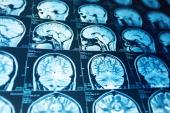Left Atrial Dysfunction Tied to Cerebral Infarcts in Absence of Prior AF, Stroke
The study suggests LA function is more important than LA size for predicting future ischemic strokes, one researcher says.

For individuals without a prior history of atrial fibrillation or stroke, left atrial (LA) dysfunction is more tightly linked to risk of having an ischemic stroke than LA size, according to an analysis of the ARIC study.
Reduced LA reservoir strain, an echocardiographic measure of LA mechanical function, was associated with a greater risk of developing ischemic stroke over the long term, even after accounting for LA size and variables included in the CHA2DS2-VASc score, report lead authors Ankit Maheshwari, MD (Penn State Health Milton S. Hershey Medical Center, Hershey, PA), and Faye Norby, PhD (Smidt Heart Institute, Cedars-Sinai Health System, Los Angeles, CA).
Moreover, the best predictive model for ischemic stroke combined LA reservoir strain with the CHA2DS2-VASc variables.
The study, which was published online this week in Annals of Internal Medicine, was conducted to further explore the concept that atrial myopathy, characterized by changes in LA function and size, may spur the development of AF and in turn increase the risk of cardioembolic stroke. The idea is that detecting atrial myopathy and then treating those patients—with oral anticoagulation, for instance—may prevent a stroke, but this hasn’t been proven in a randomized trial or, consequently, adopted in clinical practice.
The current study advances the narrative by indicating that LA function, and not size, is more important when it comes to predicting stroke risk in patients without a prior history of AF or stroke. “Moving forward, if we’re going to translate this idea of atrial myopathy to clinical practice, using left atrial function would be a better way to do that,” Maheshwari told TCTMD, noting that more work needs to be done before applying the results to patient management.
Turning to ARIC
For the analysis, the investigators examined data on 4,917 participants (mean age 75; 60% women) in ARIC, a prospective cohort study that included Black and white adults across the US, who had no previous stroke or AF. LA function and size were measured using two-dimensional speckle-tracking echocardiography. Over a mean follow-up of 6.6 years, 3.6% had an ischemic stroke.
I think we’re close to influencing clinical practice but there are a few more critical studies that are needed. Ankit Maheshwari
The cumulative incidence of ischemic stroke over 5 years was increased in the lowest quintiles of LA reservoir, conduit, and contractile strain (2.99%, 3.18%, and 2.15%, respectively) than in the highest quintiles (1.42%, 1.17%, and 1.91%, respectively). Incidence also was higher for patients with severe LA enlargement versus those with normal LA size (1.99% vs 1.71%).
When it came to predicting risk of ischemic stroke, the best model was one that included left atrial reservoir strain and the CHA2DS2-VASc variables. Using this model, “11.6% of the 112 participants with stroke after 5 years were reclassified to higher risk categories and 1.8% to lower risk categories,” the researchers report.
Of note, LA size—according to LA volume index—was not associated with risk of ischemic stroke after accounting for LA reservoir strain and incident AF, confirming suspicions, Maheshwari said, that the mechanics of the left atrium would provide more information about stroke risk than its size.
Not Ready for Prime Time
Additional studies are needed before these results can lead to a change in practice, Maheshwari said, pointing to the need for validation studies in independent cohorts and ultimately RCTs showing that identifying patients with atrial myopathy and treating them with anticoagulation improves clinical outcomes with acceptable safety.
“I think we’re close to influencing clinical practice but there are a few more critical studies that are needed,” he said.
In an accompanying editorial, Darae Ko, MD, and Emelia Benjamin, MD (both Boston Medical Center, MA), applaud the investigators “for bringing attention to the possible role of atrial cardiopathy in mediating cardioembolic stroke in the absence of AF.”
They note that atrial cardiopathy may spark LA thromboembolism in the absence of AF and explain at least a proportion of the embolic strokes of undetermined source (ESUS). Two prior trials, NAVIGATE ESUS and RE-SPECT ESUS, failed to show a benefit of using direct oral anticoagulants (DOACs) instead of aspirin in patients with ESUS, although a secondary analysis of the former trial suggested that DOAC therapy may help in patients with atrial myopathy—specifically, moderate-to-severe LA enlargement.
There is an ongoing trial, called ARCADIA, exploring whether DOAC therapy will prevent recurrent strokes in patients with cryptogenic strokes and atrial cardiopathy. But, “in light of the results of the NAVIGATE ESUS and RE-SPECT ESUS trials, there is insufficient equipoise to test anticoagulation for primary prevention of ischemic stroke in patients with atrial cardiopathy and without AF in a clinical trial,” Ko and Benjamin write.
As for the current analysis by Maheshwari et al, Ko told TCTMD that there are additional steps needed before the results can have a clinical impact. “You always have to be very careful about applying the results of observational studies to clinical practice right away,” she said, adding that ARCADIA will likely influence patient management.
“This study probably supports the hypothesis that’s currently being tested in the ARCADIA trial but we have to wait for the results . . . to really move to a next step,” Ko said.
Todd Neale is the Associate News Editor for TCTMD and a Senior Medical Journalist. He got his start in journalism at …
Read Full BioSources
Maheshwari A, Norby FL, Inciardi RM, et al. Left atrial mechanical dysfunction and the risk for ischemic stroke in people without prevalent atrial fibrillation or stroke: a prospective cohort study. Ann Intern Med. 2022;Epub ahead of print.
Ko D, Benjamin EJ. Atrial cardiopathy and cardioembolic stroke. Ann Intern Med. 2022;Epub ahead of print.
Disclosures
- The ARIC study has been funded in whole or in part with federal funds from the National Heart, Lung, and Blood Institute (NHLBI). The current study was funded by the NHLBI.
- Maheshwari and Norby report no relevant conflicts of interest.
- Ko reports personal research funding from the NHLBI and the Boston University School of Medicine, institutional research funding from Boston Scientific; consulting fees from Eagle Pharmaceuticals; and support from the CardioVascular Clinical Trialists Forum.
- Benjamin reports receiving grants from the American Heart Association (AHA) and the NHLBI; serving on the CARDIA observational study monitoring board; and having been president of the Greater Boston board of directors for the AHA.





Comments